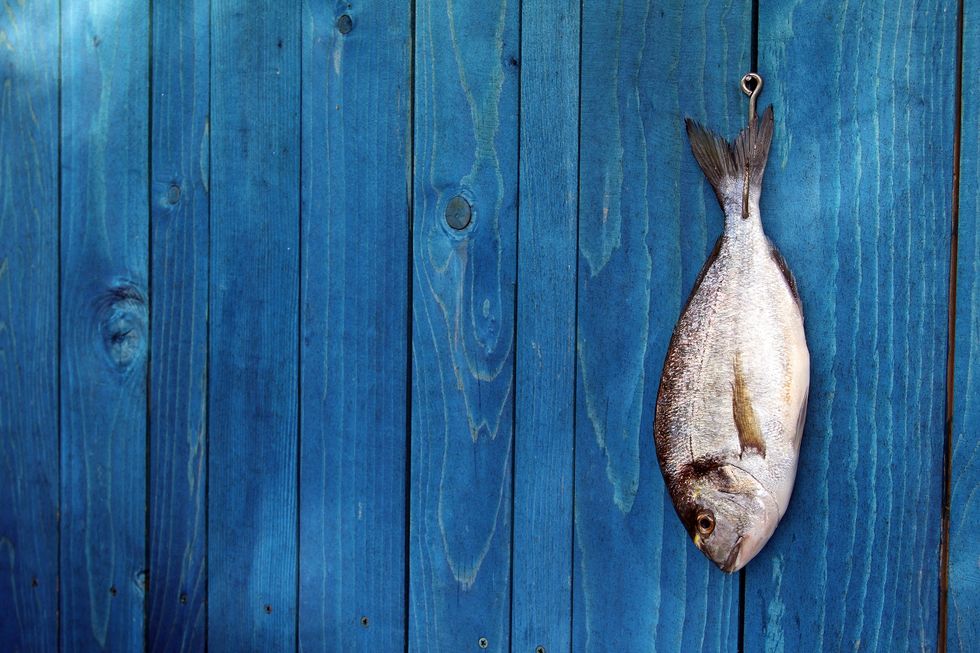
From salmon to mussels, from omegas to spring, from sushi to "steaks": Slow Fish reveals the myths about fish
Can't wait to make yourself a nice carpaccio of freshly caught amberjack? Stop !!! Is the beach on your doorstep, and are you about to force yourself on a salmon diet three times a week? Stop!!! First, read the eight myths about fish, identified by Slow Food - the global leading non-profit organization for promoting the consumption of "good and fair" food - on the occasion of the 2017 edition of Slow Fish.
1 - Salmon is the perfect fish for nutrition and diets
In tables and graphs of good nutrition, the place of honor always goes to him: King Salmon presented as the icon of healthy & good. Nothing more false. 90% of the salmon in circulation today is farmed, loaded with antibiotics, fed with flours composed of slaughterhouse waste as well as other fish, colored with colors whose palette of colors (from pale pink to orange, preferred from the Italians to the red preferred by the Americans) that resemble those who consult to choose the color of their walls or bathroom tiles. The government of Norway - the largest producer globally - advises against its consumption by pregnant women and children. On the diet side, to get the famous "good" fats from fish, it is better to consume anchovies, half the calories of salmon (96 against 180), and are certainly not farmed!
2 - The fish for sushi must be freshly caught
False! How fake ??? False because fish to eat raw - and therefore for sushi, but also carpaccio, tartare, etc. - it must be very fresh, but for safety reasons, it must be "knocked down." What does it mean? Frozen in a blast chiller will bring it very quickly to a temperature where any possible parasite will die - including the infamous anisakids, which can inhabit Mediterranean and bluefish. For public places serving raw fish, it is mandatory. So what about making raw fish at home? You need to have a freezer marked with three or more stars and keep the fish there for at least four days. Don't worry: it will remain very fresh!
3 - The big fish, of which the "steaks" are eaten, is more valuable
Who says that? In fact, it's just more expensive. And perhaps more convenient to cook and eat - this must be put on because it has no bones and is prepared on the fly with the speed of a slice of meat. In reality, in addition to the environmental reasons for cutting down on the consumption of swordfish, tuna & c (which have been plundered and therefore scarce dramatically), there are health reasons: they are much more loaded with contaminants heavy metals.
4 - Clams and mussels? They live in the "sewers" and are polluted.
It is enough to know the origin - which is easily understood by the label that accompanies the sealed net in which they are marketed. Having identified a quality farm - which favors low densities and is positioned safely concerning substances and bacteria that are harmful to our health, we can gorge on mussels, clams, and oysters in all serenity. They are a healthy food (they do not require feed because the nutrients are filtered by themselves from the seawater), low-calorie (the mussels appear "fat" but have only 60 kcal!) And from the point of view of the environment, they represent the shape of more sustainable farming.
5 - Fresh fish is more likely to be local
Maybe! The problem is that "fresh" is regularly offered fish that may have traveled around half the planet. Fresh fish from 40 countries are landed in Italy every day, and many overlook the Pacific or Atlantic. The secret is to read the label carefully again - possibly knowing a minimum of origin areas. The label must contain: 1) commercial name of the species, for example, "sea bream." 2) production method ("fished," "caught in freshwater," "farmed") 3) capture area, the famous FAO capture areas (e.g. "Area 47: Atlantic, Southeast") or the country of origin in the case of farmed fish 4) physical state: defrosted, defrosted 5) presence of additives, for example, “contains sulfites" for crustaceans legally added with sulfites.
6 - For health, it is better to eat as much fish as possible
Of course, fish is good for you, especially the blue one, rich in the famous omega-3s, so nutritionists and dieticians always recommend it. But it is not the only valid source for incorporating these precious substances: seeds, for example, those of chia, and nuts are also very rich. Other sea products are not fish and are healthy both for us and for the environment: algae, even jellyfish, and above all, mollusks and crustaceans. Why not?
7 - There is no seasonality of fish
It exists and how !!! And following it is a must to respect the sea. And then the right fish is often better because it is caught nearby and therefore fresher and healthier. Let's start from spring: perfect sea bass, gurnard, and bonito, but also the blue horse mackerel, sea bream, mackerel, and bream. And then there is the Peccia, good and sustainable local fish. And in the summer, when the craving for fish increases hand in hand with the heat and a good cold white wine? Anchovies, gallinule, Mahi Mahi, sea bream, amberjack, white breams, sardines, sea bass ... You are spoiled for choice!
8 - The soles are sole, and the cod is cod, even if they have different prices
Warning! the phenomenon is more and more widespread (since the fish considered more valuable are becoming scarce) and is called species replacement. When, despite what the label says, we buy a Senegalese language (value 4 euro/kg) instead of sole, Broome (value 7 euro/kg) instead of stockfish and cod, baby octopus instead of octopus ( value 4 euro/kg), we are the victim of commercial fraud in all respects. So what? You need to know them: careful consumers ultimately mean happier consumers.






